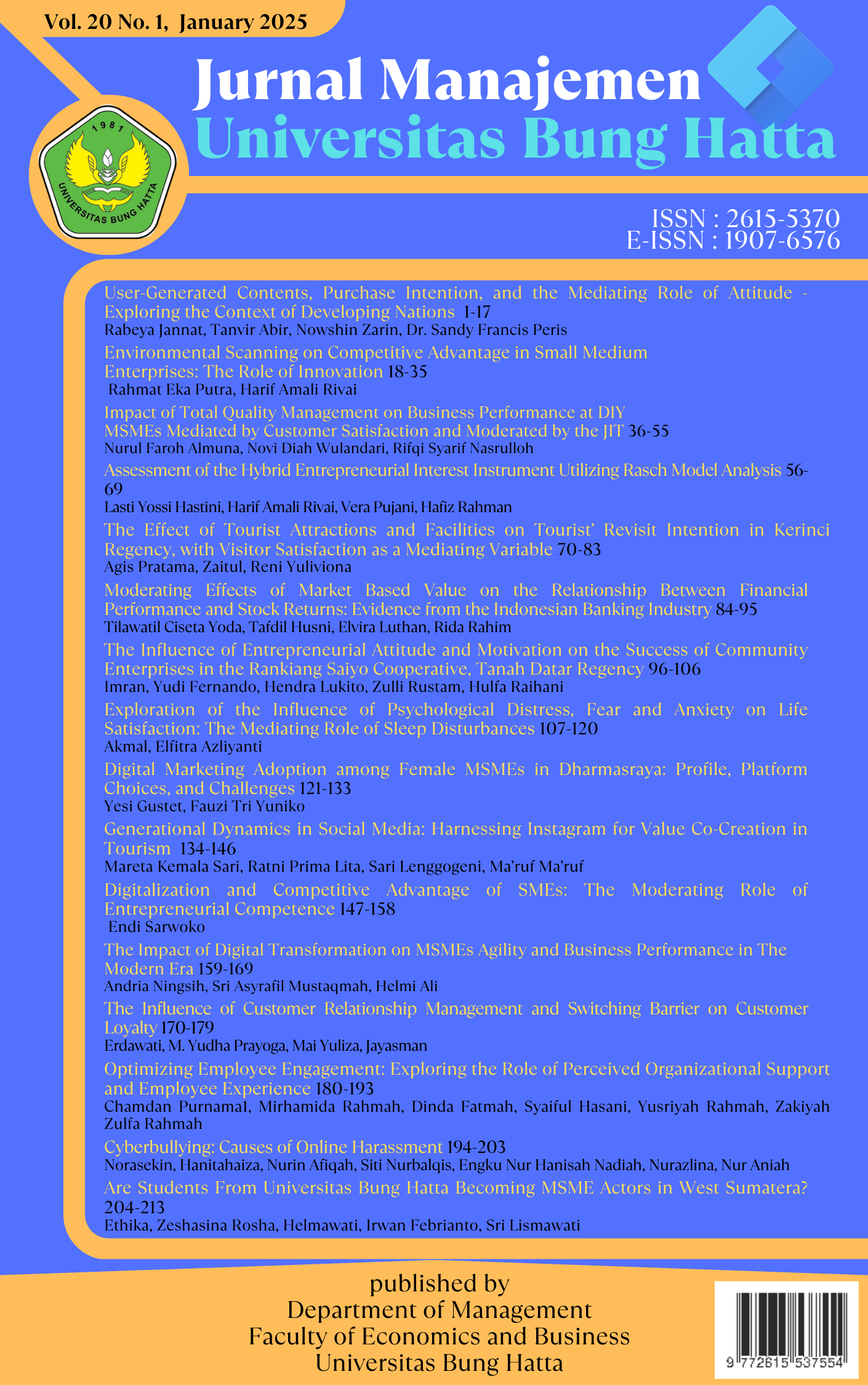User-Generated Contents, Purchase Intention, and the Mediating Role of Attitude- Exploring the Context of Developing Nations
DOI:
https://doi.org/10.37301/jmubh.v20i1.27092Keywords:
user-generated content, attitude, purchase intention, developing countries, social mediaAbstract
This paper explored the impact of User-generated content (UGC) on consumer purchase intention and the mediating role of attitude towards UGC. By analyzing factors like brand engagement, perceived credibility, perceived usefulness, and information quality, this research aims to shed light on the connections between these variables. Quantitative data was collected from 208 individuals using an online survey. SEM-PLS was used for data analysis. Findings revealed that the identified components of UGC significantly influence attitude, which, in turn, shapes purchase intentions. This research contributes to the understanding of how UGC can be harnessed by marketers to communicate value to customers and enhance purchase intention. It also highlights the indirect impact of UGC on purchase intention, mediated by the attitude toward UGC. Apart from enriching the existing literature, particularly from a developing nation’s perspective; the findings provide insights for mobile phone marketers in Bangladesh to benefit from the potential of authentic customer experiences to drive purchase intentions in a dynamic digital landscape.
References
Abir, T., Rahman, M. A., Yazdani, D. M. N.-A., Khan, R. H., Supty, S. S. A., & Hamid, A. B. A. (2020). Electronic Word of Mouth (e-WOM) and consumers’ purchase decisions: Evidences from Bangladesh. Journal of Xi’an University of Architecture & Technology, 12, 367–382.
Abu Zayyad, H. M., Obeidat, Z. M., Alshurideh, M. T., Abuhashesh, M., Maqableh, M., & Masa’deh, R. (2021). Corporate social responsibility and patronage intentions: The mediating effect of brand credibility. Journal of Marketing Communications, 27(5), 510–533.
Assaker, G. (2019). Age and gender differences in online travel reviews and user-generated-content (UGC) adoption: extending the technology acceptance model (TAM) with credibility theory. Journal of Hospitality Marketing & Management, 29(4), 428–449.
Babić Rosario, A., De Valck, K., & Sotgiu, F. (2020). Conceptualizing the electronic word-of-mouth process: What we know and need to know about eWOM creation, exposure, and evaluation. Journal of the Academy of Marketing Science, 48(3), 422–448.
Bahtar, A. Z., & Muda, M. (2016). The impact of User–Generated Content (UGC) on product reviews towards online purchasing–A conceptual framework. Procedia Economics and Finance, 37, 337–342.
Bouteraa, M., & Al-Aidaros, A.-H. (2020). The role of attitude as mediator in the intention to have Islamic will. International Journal of Advanced Research in Economics and Finance, 2(1), 22–37.
Cheng, F.-F., Wu, C.-S., & Chen, Y.-C. (2020). Creating customer loyalty in online brand communities. Computers in Human Behavior, 107, 105752.
Chin, W. W. (1998). The partial least squares approach to structural equation modeling. Modern Methods for Business Research, 295(2), 295–336.
Cohen, J. (2013). Statistical power analysis for the behavioral sciences. routledge.
Daugherty, T., Eastin, M. S., & Bright, L. (2013). Exploring consumer motivations for creating user-generated content. Journal of Interactive Advertising, 8(2), 16–25. https://doi.org/https://doi.org/10.1080/15252019.2008.10722139
Deb, S. K., Nafi, S. M., & Valeri, M. (2024). Promoting tourism business through digital marketing in the new normal era: a sustainable approach. European Journal of Innovation Management, 27(3), 775–799.
Demba, D., Chiliya, N., Chuchu, T., & Ndoro, T. (2019). How user-generated content advertising influences consumer attitudes, trust and purchase intention of products and services. Communicare: Journal for Communication Sciences in Southern Africa, 38(1), 136–149.
Demoulin, N. T. M., & Coussement, K. (2020). Acceptance of text-mining systems: The signaling role of information quality. Information & Management, 57(1), 103120.
Dhaka Tribune. (2024, February 12). Internet users in Bangladesh reach 131m as of 2023. https://www.dhakatribune.com/bangladesh/339218/internet-users-in-bangladesh-reach-131m-as-of-2023
Dwidienawati, D., Tjahjana, D., Abdinagoro, S. B., & Gandasari, D. (2020). Customer review or influencer endorsement: which one influences purchase intention more? Heliyon, 6(11).
Eti, I. A., Horaira, M. A., & Bari, M. M. (2021). Power and stimulus of social media marketing on consumer purchase intention in Bangladesh during the COVID-19. International Journal of Research in Business and Social Science (2147-4478), 10(1), 28–37.
Fox, A. K., Bacile, T. J., Nakhata, C., & Weible, A. (2018). Selfie-marketing: exploring narcissism and self-concept in visual user-generated content on social media. Journal of Consumer Marketing, 35(1), 11–21.
Gabelaia, I. (2022). The impact of user-generated content on customer purchase intentions of online shoppers. International Conference on Reliability and Statistics in Transportation and Communication, 437–449.
Gabelaia, I., & McElroy, J. W. (2023). The Impact of User-Generated Marketing on Creating Greater Audience Connections and Brand Loyalty. International Conference on Reliability and Statistics in Transportation and Communication, 389–403.
Geng, R., & Chen, J. (2021). The influencing mechanism of interaction quality of UGC on consumers’ purchase intention–an empirical analysis. Frontiers in Psychology, 12, 697382.
Gupta, R., & Nair, K. (2021). Customer engagement and brand communication strategies during covid-19. International Journal of Entrepreneurship, 25, 1–6.
Guzzo, T., Ferri, F., & Grifoni, P. (2022). What factors make online travel reviews credible? The consumers’ credibility perception-CONCEPT model. Societies, 12(2), 50.
Hafez, M. (2021). The impact of social media marketing activities on brand equity in the banking sector in Bangladesh: the mediating role of brand love and brand trust. International Journal of Bank Marketing, 39(7), 1353–1376.
Hair, J. F., Ringle, C. M., & Sarstedt, M. (2011). PLS-SEM: Indeed a silver bullet. Journal of Marketing Theory and Practice, 19(2), 139–152. https://doi.org/10.2753/MTP1069-6679190202
Hair, J. F., Risher, J. J., Sarstedt, M., & Ringle, C. M. (2019). When to use and how to report the results of PLS-SEM. European Business Review.
Halim, E. M., & Candraningrum, D. A. (2021). The Influence of User-Generated Content Towards Somethinc Skincare Purchase Intention. International Conference on Economics, Business, Social, and Humanities (ICEBSH 2021), 831–836.
Harrigan, M., Feddema, K., Wang, S., Harrigan, P., & Diot, E. (2021). How trust leads to online purchase intention founded in perceived usefulness and peer communication. Journal of Consumer Behaviour, 20(5), 1297–1312.
Henseler, J., Ringle, C. M., & Sarstedt, M. (2015). A new criterion for assessing discriminant validity in variance-based structural equation modeling. Journal of the Academy of Marketing Science, 43, 115–135.
Ho Nguyen, H., Nguyen-Viet, B., Hoang Nguyen, Y. T., & Hoang Le, T. (2022). Understanding online purchase intention: the mediating role of attitude towards advertising. Cogent Business & Management, 9(1), 2095950.
Ing, G. P., & Ming, T. (2018). Antecedents of consumer attitude towards blogger recommendations and its impact on purchase intention. Asian Journal of Business and Accounting, 11(1), 293–323.
Israfilzade, K., & Baghirova, S. (2022). Comparing the Impact of Brand and User-Generated Video Content on Online Shoppers’ Purchasing Intentions. Organizacijø Vadyba: Sisteminiai Tyrimai, 88, 69–84.
Ivana, P., & La Are, R. (2020). The Impact of User Generated Content (Online Review) Towards The Intention to Purchase on E-commerce In Jakarta. Case Study Of Tokopedia. Conference Series, 3(1), 426–443.
Khan, M. Y. H., & Abir, T. (2022). The role of social media marketing in the tourism and hospitality industry: A conceptual study on Bangladesh. In ICT as Innovator between Tourism and Culture (pp. 213–229). IGI Global.
Khan, S., Umer, R., Umer, S., & Naqvi, S. (2021). Antecedents of trust in using social media for E-government services: An empirical study in Pakistan. Technology in Society, 64, 101400.
Koththagoda, K. C., & Herath, H. (2018). Factors influencing online purchasing intention: The mediation role of consumer attitude. Journal of Marketing and Consumer Research, 42(2003), 66–74.
Langaro, D., Rita, P., & de Fátima Salgueiro, M. (2015). Do social networking sites contribute for building brands? Evaluating the impact of users’ participation on brand awareness and brand attitude. Journal of Marketing Communications, 24(2), 146–168. https://doi.org/10.1080/13527266.2015.1036100
Machdar, N. M. (2016). The effect of information quality on perceived usefulness and perceived ease of use. Business and Entrepreneurial Review, 15(2), 131–146.
Mathur, S., Tewari, A., & Singh, A. (2021). Modeling the Factors affecting Online Purchase Intention: The Mediating Effect of Consumer’s Attitude towards User- Generated Content. Journal of Marketing Communications, 28(7), 725–744. https://doi.org/10.1080/13527266.2021.1936126
Mayrhofer, M., Matthes, J., Einwiller, S., & Naderer, B. (2020). User generated content presenting brands on social media increases young adults’ purchase intention. International Journal of Advertising, 39(1), 166–186.
McClure, C., & Seock, Y.-K. (2020). The role of involvement: Investigating the effect of brand’s social media pages on consumer purchase intention. Journal of Retailing and Consumer Services, 53, 101975.
Moore, S. G., & Lafreniere, K. C. (2020). How online word‐of‐mouth impacts receivers. Consumer Psychology Review, 3(1), 34–59.
Muda, M., & Hamzah, M. I. (2021). Should I suggest this YouTube clip? The impact of UGC source credibility on eWOM and purchase intention. Journal of Research in Interactive Marketing, 15(3), 441–459.
Muhammad, S. S., Dey, B. L., Kamal, M. M., & Alwi, S. F. S. (2021). Consumer engagement with social media platforms: a study of the influence of attitudinal components on cutting edge technology adaptation behaviour. Computers in Human Behavior, 121, 106802.
Mulyani, V. G., Najib, M. F., & Guteres, A. D. (2021). The effect of perceived usefulness, trust and visual information toward attitude and purchase intention. Journal of Marketing Innovation (JMI), 1(1).
Naeem, M., & Ozuem, W. (2022). Understanding the different types of UGC participants and social context for fashion brands: insights from social media platforms. Qualitative Market Research: An International Journal, 25(2), 181–204.
Ndlela, T., & Chuchu, T. (2016). Celebrity endorsement Advertising: Brand awareness, brand recall, brand loyalty as antecedence of South African young consumers’ purchase behaviour. Journal of Economics and Behavioral Studies, 8(2 (J)), 79–90.
Nosita, F., & Lestari, T. (2019). The influence of user generated content and purchase intention on beauty products. J. Mgt. Mkt. Review, 4(3), 171–183.
Nusairat, N. M., Alroale, M. A., Al Qeed, M., Al-Gasawneh, J. A., Hammouri, Q., Ahmad, A., & Abdellatif, H. (2021). User-generated content-consumer buying intentions nexus: the mediating role of brand image. Academy of Strategic Management Journal, 20(4), 1–12.
Oliveira, T., Araujo, B., & Tam, C. (2020). Why do people share their travel experiences on social media? Tourism Management, 78, 104041.
Ozuem, W., Willis, M., Howell, K., Ranfagni, S., & Rovai, S. (2024). Examining user-generated content, service failure recovery and customer–brand relationships: an exploration through commitment-trust theory. Internet Research, 34(3), 784–809.
Peris, S. F., Supian, K., Hasanat, M. W., & Hoque, A. (2021). An examination of SME sustainable economic development through green entrepreneurial and technological orientation at post covid-19: a preliminary study. Journal of Islamic, 6(42), 161-179.
Racherla, P., & Friske, W. (2012). Perceived ‘usefulness’ of online consumer reviews: An exploratory investigation across three services categories. Electronic Commerce Research and Applications, 11(6), 548–559.
Rajamma, R. K., Paswan, A., & Spears, N. (2020). User-generated content (UGC) misclassification and its effects. Journal of Consumer Marketing, 37(2), 125–138.
Rasool, G., & Pathania, A. (2021). Reading between the lines: untwining online user-generated content using sentiment analysis. Journal of Research in Interactive Marketing, 15(3), 401–418.
Ray, A., & Bala, P. K. (2021). User generated content for exploring factors affecting intention to use travel and food delivery services. International Journal of Hospitality Management, 92, 102730.
Ringle, C. M., Sarstedt, M., Mitchell, R., & Gudergan, S. P. (2020). Partial least squares structural equation modeling in HRM research. The International Journal of Human Resource Management, 31(12), 1617–1643.
Rusu, G., Orzan, M.-C., Savin, P. S., Goga, E., & Prelipcean, M. (2023). The Role of Integrated Communication Strategies with Social Media in Creating and Nurturing Relationships with New Brands: A Consumer Behavior Perspective. Journal of Emerging Trends in Marketing and Management, 1(3), 56–63.
Sashi, C. M. (2021). Digital communication, value co-creation and customer engagement in business networks: a conceptual matrix and propositions. European Journal of Marketing, 55(6), 1643–1663.
Sawaftah, D., Aljarah, A., & Lahuerta-Otero, E. (2021). Power brand defense up, my friend! stimulating brand defense through digital content marketing. Sustainability, 13(18), 10266.
Sethi, R. S., Kaur, J., & Wadera, D. (2018). Purchase intention survey of millennials towards online fashion stores. Academy of Marketing Studies Journal, 22(1), 1–16.
Sheeraz, M., Khattak, A. K., Mahmood, S., & Iqbal, N. (2016). Mediation of attitude toward brand on the relationship between service brand credibility and purchase intentions. Pakistan Journal of Commerce and Social Sciences (PJCSS), 10(1), 149–163.
Tajvidi, M., Richard, M.-O., Wang, Y., & Hajli, N. (2020). Brand co-creation through social commerce information sharing: The role of social media. Journal of Business Research, 121, 476–486.
Taleb, I., Serhani, M. A., Bouhaddioui, C., & Dssouli, R. (2021). Big data quality framework: a holistic approach to continuous quality management. Journal of Big Data, 8(1), 76.
Thirakulwanich, A., & Sawmong, S. (2021). Factors Influencing Shoppers’ Behavioral Intention to Purchase Smart Phones: Digital Transformation Through YouTube User Generated Content. International Scientific Conference on Innovations in Digital Economy, 35–50.
Utami, P. D. P., & Rahyuda, K. (2019). The antecedents of consumers’ attitude and its consequences on online purchase intention. International Research Journal of Management, IT and Social Sciences, 6(4), 107–117.
Ventre, I., & Kolbe, D. (2020). The impact of perceived usefulness of online reviews, trust and perceived risk on online purchase intention in emerging markets: A Mexican perspective. Journal of International Consumer Marketing, 32(4), 287–299.
Wicaksono, A. I., & Ishak, A. (2022). Promoting online purchase intention through website quality, EWOM, receiver perspective, consumer satisfaction and brand image. International Journal of Research in Business and Social Science (2147-4478), 11(1), 12–23.
Zhang, K. Z. K., Zhao, S. J., Cheung, C. M. K., & Lee, M. K. O. (2014). Examining the influence of online reviews on consumers’ decision-making: A heuristic–systematic model. Decision Support Systems, 67, 78–89.
Zhou, S., Li, T., Yang, S., & Chen, Y. (2022). What drives consumers’ purchase intention of online paid knowledge? A stimulus-organism-response perspective. Electronic Commerce Research and Applications, 52, 101126.
Zhuang, W., Zeng, Q., Zhang, Y., Lin, D., & Fan, W. (2024). What makes UGC more popular on social media platforms? Insights from information adoption theory. Behaviour & Information Technology, 1–18.
Zhuang, W., Zeng, Q., Zhang, Y., Liu, C., & Fan, W. (2023). What makes user-generated content more helpful on social media platforms? Insights from creator interactivity perspective. Information Processing & Management, 60(2), 103201.
Downloads
Published
Issue
Section
License
Copyright (c) 2025 Dahliana, Rabeya Jannat, Tanvir Abir, Nowshin Zarin, Sandy Francis Peris

This work is licensed under a Creative Commons Attribution-ShareAlike 4.0 International License.
Authors who publish with Jurnal Manajemen Universitas Bung Hatta agree to the following terms:
- Authors retain copyright and grant the journal right of first publication with the work simultaneously licensed under a Creative Creative Commons Attribution-ShareAlike 4.0 International License that allows others to share the work with an acknowledgement of the work's authorship and initial publication in Jurnal Manajemen Universitas Bung Hatta.
- The author holds the copyright of the submitted and published articles, with the understanding that articles are disseminated under the Creative Commons Attribution-ShareAlike 4.0 International License..
- The editor team is entitled to do the editing in accordance with the guidelines for writing or template in the Jurnal Manajemen Universitas Bung Hatta.
This work is licensed under a Creative Commons Attribution-ShareAlike 4.0 International License.












